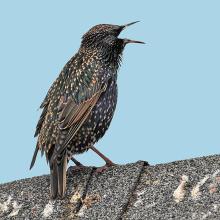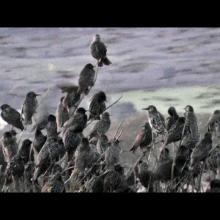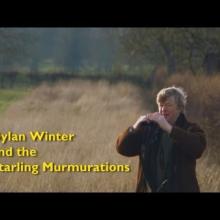

Join BirdNote tomorrow, November 30th!
Illustrator David Sibley and actor H. Jon Benjamin will face off in the bird illustration battle of the century during BirdNote's Year-end Celebration and Auction!
European Starlings were present in great numbers in ancient Rome. They swarmed in massive flocks or murmurations — thousands of individuals cascading and folding in awe-inspiring geometric patterns in the sky. Roman augurs, or diviners, scrutinized these patterns for signs of how the gods were feeling that day. Some flock patterns offered more auspicious signs or omens than others. From time to time, it may have seemed like the future of Rome itself hung on the correct reading of the movements of these very common but highly adaptable birds. Be sure to watch the video, below.
BirdNote®
Romans Saw Omens in Starling Flocks
Written by Bob Sundstrom
This is BirdNote.
[European Starling voice, http://macaulaylibrary.org/audio/107248, 0.26-.29]
European Starlings arrived in North America in the 19th century. But they’ve lived side by side with humans since way before then.
In the European Starling’s native range of Europe and western Asia, people have been farming, herding, and erecting settlements for millennia. And starlings have adapted alongside them, finding nest cavities in buildings and flocking around any agricultural activity that might promise seeds, fruit, or a bounty of insect prey.
[Ambient music, Synaulia-Music of Ancient Rome Vol. 2 performed by Walter Maioli]
We know for certain that starlings were present in great numbers in ancient Rome. They swarmed in massive flocks of the kind we today call murmurations – thousands of individuals cascading and folding in awe-inspiring geometric patterns in the sky.
Roman augurs, or diviners, scrutinized these patterns for signs of how the gods were feeling that day. Divination was crucial for major decision-making: if there was a key battle in the offing or political intrigue brewing, the augurs looked to the skies. “Taking the auspices,” it was called – to see if the gods gave, or withheld, their approval.
Some flock patterns offered more auspicious signs or omens than others. From time to time, it may have seemed like the future of Rome itself hung on the correct reading of the movements of these very common but highly adaptable birds.
For BirdNote, I’m Mary McCann.
###
Bird sounds provided by The Macaulay Library of Natural Sounds at the Cornell Lab of Ornithology, Ithaca, New York. 107248 Recorded by Wilbur L Hershberger. Synaulia-Music of Ancient Rome Vol. 2 performed by Walter Maioli.
BirdNote’s theme music was composed and played by Nancy Rumbel and John Kessler.
Producer: John Kessler
Executive Producer: Sallie Bodie
© 2016 Tune In to Nature.org September 2018 / 2020 Narrator: Mary McCann
ID# EUST-05-2016-09-29 EUST-05
About divination in Rome https://books.google.com/books?id=xQd82l39KX4C&pg=PA166&lpg=PA166&dq=ro…
Augury and starlings in Ancient Rome http://www.bbc.com/news/magazine-28583052
Rome http://www.nytimes.com/2007/04/22/magazine/22birds.t.html?_r=0






